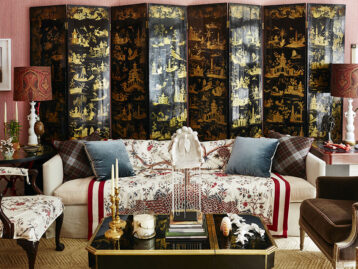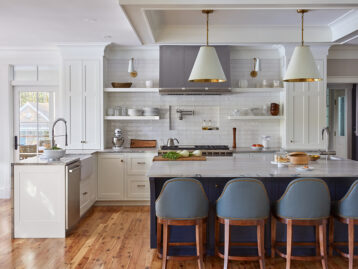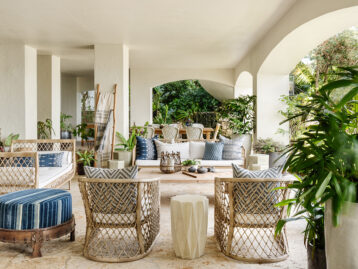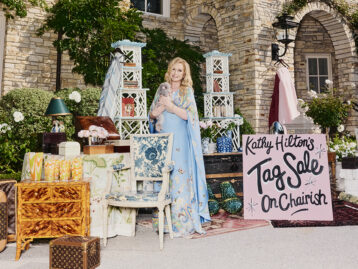He’s worked in film production, home design, and as the bass player in a punk rock band, but Max Humphrey has found his greatest success as the founder of his own eponymous design firm. His projects since have been just as varied as his professional background, ranging from home interiors to a food truck, a dental office, and a podcast studio (no, sadly not the one where our host Michael Boodro records The Chairish Podcast). The design industry has taken note of Max’s layered, masculine style — he was a featured “Next Wave” designer in House Beautiful and was named one of Country Living‘s 100 most creative people. Max’s new book, Modern Americana, guides users through his style, which he refers to as, “knowing who you are, what you want to say, and not giving a damn.”
Below, learn more about Max Humphrey, his favorite things to collect, and his design influences, and be sure to shop some of his finds, right here on Chairish.

Your book is called Modern Americana and delves into how it can be applied to different types of homes. Can you talk a bit about that? How does it work in a city apartment vs a rural home, for instance?
The whole point of Modern Americana is that if you have confidence and a DIY spirit, you can pull off the style regardless of whether you live in a city or out in the boonies. I would never think to fill a modern house up with only modern furniture or an old house up with only old junk. It’s about the mix and buying things you love regardless of whether they fit.
You grew up in New England, moved to LA in your 20s, and moved to Portland in 2016, where you launched your own firm. How do you think these different places influenced your aesthetic?
There’s definitely an aesthetic connection between where I grew up in the woods of New England and where I live now, in the wooded outskirts of Portland, Oregon. There’s a strong sense of incorporating aspects of the local landscape indoors in both places. Living in LA taught me that anything goes decor-wise!

On your site, you mention that “every room should show signs of life.” That really resonates… tell us a little more about that.
Showing signs of life is more of a reminder to myself and my co-maximalists that real people don’t actually live inside perfectly styled Pinterest rooms. I’d go cuckoo in an all-white minimalist room — I find a bit of clutter inspiring and comforting.
You work with a lot of vintage pieces in your projects. As a designer, why do you think that’s important?
Buying vintage is a way to support sustainability. We’re sold brand new “sustainable” things all the time, but reusing something you already own or buying a piece that’s been around for 50 years is way cooler.

Any advice for people who are just getting started with buying vintage and don’t know where to start?
My advice is to balance your online vintage shopping with some IRL experiences. Chit-chatting with shop owners is a great way to create a story around the pieces you bring back into your home. You can strike up convos with sellers online too. It’s fun hearing about where things came from and what lives they led.
What are some of your favorite things to collect personally?
I’m always collecting something. It’s weird when I talk to people who don’t collect anything. Lately I’ve been on summer camp vibes-collecting excursions, and have been stocking up on old camp blankets, lanterns, coolers, weird old wooden signs, and general outdoorsy nostalgia.

Your rooms feature lots of plaids, ginghams, and many different patterns. How do you know when you’re playing with patterns successfully vs when something just clashes?
Who says patterns clash? I say they don’t, so they don’t.
In addition to your residential work, you’ve had some really interesting commercial projects, including a restaurant in North Carolina, a tasting room in California Wine Country, and even a dental office in Downtown LA. Tell us a bit about those — how does your approach to commercial projects differ from residential, or does it?
My approach to commercial projects is just the same as residential ones. I go with my gut and try to design around how the space will actually be used. Since I come from the home design world, most of my commercial spaces have a home-y look and feel.

Do you have any dream projects to take on? Or maybe dream clients?
I have a list of dream projects but one thing I’d like to do is come up with the stage design for a touring band or singer. It would be a challenge to create something that was interesting up close as well as visible from the nosebleed seats.
Who’s a design icon you often find yourself referring back to in terms of your work and personal style?
Since I was a youngster and my parents would take me to the Polo factory outlet in Manchester, Vermont, I’ve been a devout follower of Ralph Lauren. Hopefully one day I’ll get invited to his Double RL Ranch in Colorado for movie night.

All photos by Christopher Dibble, from Modern Americana, now available from Max Humphrey


































